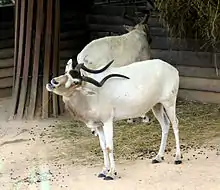Pygarg
The pygarg (/ˈpaɪɡɑːɡ/[1]) is an animal mentioned in the Bible in Deuteronomy 14:5 as one of the animals permitted for food. The Septuagint translates the Hebrew ḏîšōn (דִּישֹׁן) as pygargos in Koiné Greek ("white-rumped", from pyge "buttocks" and argo "white"),[1] and the King James Version takes from there its term pygarg.

Henry Baker Tristram (1867) proposed that the pygarg was the Saharan antelope addax and described it as "a large animal, over 3 1⁄2 feet [1 m] high at the shoulder, and, with its gently-twisted horns, 2 1⁄2 feet [80 cm] feet long. Its colour is pure white, with the exception of a short black mane, and a tinge of tawny on the shoulders and back".[2]
Outside the biblical use, the term was also applied to the Siberian roe deer in the 18th century,[3] whose specific name is pygargus in scientific Latin.
References
- "pygarg". Oxford English Dictionary (Online ed.). Oxford University Press. (Subscription or participating institution membership required.)
- Henry Baker Tristram, The Natural History of the Bible (1867).
- Pallas, P.S. (1793). Voyages du professeur Pallas, dans plusieurs provinces de l'Empire de Russie et dans l'Asie septentrionale (in Latin and French). p. 25.
 This article incorporates text from a publication now in the public domain: Easton, Matthew George (1897). Easton's Bible Dictionary (New and revised ed.). T. Nelson and Sons. Missing or empty
This article incorporates text from a publication now in the public domain: Easton, Matthew George (1897). Easton's Bible Dictionary (New and revised ed.). T. Nelson and Sons. Missing or empty |title=(help)